

Ordovician–Silurian extinction event. Millions of years ago The blue graph shows the apparent percentage (not the absolute number) of marine animalgenera becoming extinct during any given time interval.
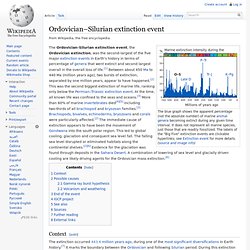
It does not represent all marine species, just those that are readily fossilized. The labels of the "Big Five" extinction events are clickable hyperlinks; see Extinction event for more details. (source and image info) Ordovician meteor event. Permian–Triassic extinction event. Millions of years ago P–Tr Plot of extinction intensity (percentage of genera that are present in each interval of time but do not exist in the following interval) vs time in the past for marine genera.[1] Geological periods are annotated (by abbreviation and colour) above. The Permian–Triassic extinction event is the most significant event for marine genera, with just over 50% (according to this source) failing to survive. (source and image info) Arthropod. Their vision relies on various combinations of compound eyes and pigment-pit ocelli: in most species the ocelli can only detect the direction from which light is coming, and the compound eyes are the main source of information, but the main eyes of spiders are ocelli that can form images and, in a few cases, can swivel to track prey.
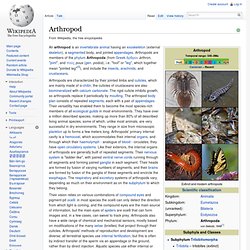
Arthropods also have a wide range of chemical and mechanical sensors, mostly based on modifications of the many setae (bristles) that project through their cuticles. Arthropods' methods of reproduction and development are diverse; all terrestrial species use internal fertilization, but this is often by indirect transfer of the sperm via an appendage or the ground, rather than by direct injection. Aquatic species use either internal or external fertilization. Almost all arthropods lay eggs, but scorpions give birth to live young after the eggs have hatched inside the mother. Ordovician. Life continued to flourish during the Ordovician as it did in the Cambrian, although the end of the period was marked by a significant mass extinction.
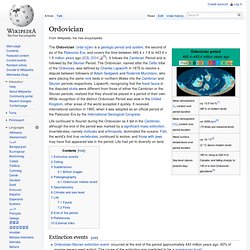
Invertebrates, namely mollusks and arthropods, dominated the oceans. Fish, the world's first true vertebrates, continued to evolve, and those with jaws may have first appeared late in the period. Life had yet to diversify on land. Proto-Tethys Ocean. Khanty Ocean. Rheic Ocean. The Rheic Ocean was a Paleozoic ocean between the large continent Gondwana to the south and the microcontinents Avalonia and others to the north.
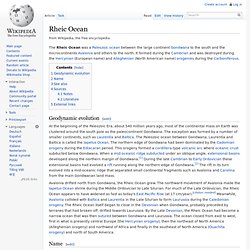
It formed during the Cambrian and was destroyed during the Hercynian (European name) and Alleghenian (North American name) orogenies during the Carboniferous. Geodynamic evolution[edit] Name[edit] See also[edit] Morais Ophiolite Complex. Paleo-Tethys Ocean. Map of Paleo-Tethys Ocean.
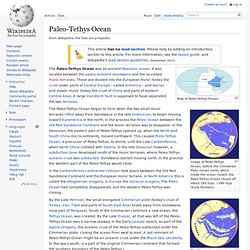
Image of Paleo-Tethys Ocean, before the Cimmerian Plate moves north, which made the ocean closed, the Paleo-Tethys Ocean closed off about 180 mya. ~290 mya (Early Permian). Iapetus Ocean. Crinoid. Crinoids are marine animals that make up the class Crinoidea of the echinoderms (phylum Echinodermata).
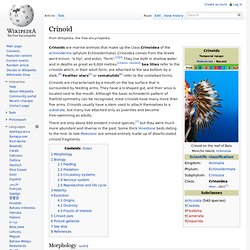
Crinoidea comes from the Greek word krinon, "a lily", and eidos, "form".[2][3] They live both in shallow water and in depths as great as 6,000 metres. [citation needed] Sea lilies refer to the crinoids which, in their adult form, are attached to the sea bottom by a stalk.[4] Feather stars[5] or comatulids[6] refer to the unstalked forms. There are only about 600 existent crinoid species,[7] but they were much more abundant and diverse in the past. Some thick limestone beds dating to the mid- to late-Paleozoic are almost entirely made up of disarticulated crinoid fragments. Morphology[edit] Like other echinoderms, crinoids have pentaradial symmetry. Taconic orogeny. Marine transgression. Maps illustrating 3 transgressions of the Belgian coast.
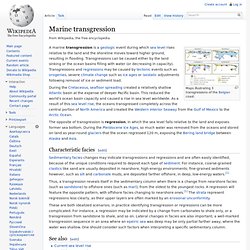
A marine transgression is a geologic event during which sea level rises relative to the land and the shoreline moves toward higher ground, resulting in flooding. Transgressions can be caused either by the land sinking or the ocean basins filling with water (or decreasing in capacity). Transgressions and regressions may be caused by tectonic events such as orogenies, severe climate change such as ice ages or isostatic adjustments following removal of ice or sediment load. During the Cretaceous, seafloor spreading created a relatively shallow Atlantic basin at the expense of deeper Pacific basin. This reduced the world's ocean basin capacity and caused a rise in sea level worldwide. Plankton. Plankton (singular plankter) are a diverse group of organisms that live in the water column and cannot swim against a current.[1] They provide a crucial source of food to many large aquatic organisms, such as fish and whales.
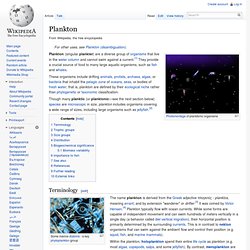
Though many planktic (or planktonic—see the next section below) species are microscopic in size, plankton includes organisms covering a wide range of sizes, including large organisms such as jellyfish.[2] Terminology[edit] The name plankton is derived from the Greek adjective πλαγκτός - planktos, meaning errant, and by extension "wanderer" or drifter.[3] It was coined by Victor Hensen.[4] Plankton typically flow with ocean currents. While some forms are capable of independent movement and can swim hundreds of meters vertically in a single day (a behavior called diel vertical migration), their horizontal position is primarily determined by the surrounding currents. Conodont. Conodonts (Greek kōnos, "cone", + odont, "tooth") are extinct chordates resembling eels, classified in the class Conodonta.
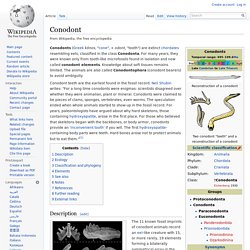
For many years, they were known only from tooth-like microfossils found in isolation and now called conodont elements. Knowledge about soft tissues remains limited. Graptolithinia. Graptolithina is a class in the animal phylum Hemichordata, the members of which are known as graptolites.

Graptolites are fossil colonial animals known chiefly from the Upper Cambrian through the Lower Carboniferous (Mississippian). A possible early graptolite, Chaunograptus, is known from the Middle Cambrian. The name graptolite comes from the Greek graptos, meaning "written", and lithos, meaning "rock", as many graptolite fossils resemble hieroglyphs written on the rock. Linnaeus originally regarded them as 'pictures resembling fossils rather than true fossils, though later workers supposed them to be related to the hydrozoans.
Echinoderm. Taxonomy and evolution[edit] Along with the chordates and hemichordates, echinoderms are deuterostomes, one of the two major divisions of the animal kingdom, the other being the protostomes. During the early development of the embryo, in deuterostomes the blastopore (the first opening to form) becomes the anus whereas in the protostomes, it becomes the mouth. In deuterosomes, the mouth develops at a later stage, at the opposite end of the blastula from the blastopore, and a gut forms connecting the two.[4] The larvae of echinoderms have bilateral symmetry but this is lost during metamorphosis when their bodies are reorganised and develop the characteristic radial symmetry of the echinoderm, typically pentamerism.[5] The characteristics of adult echinoderms are the possession of a water vascular system with external tube feet and a calcareous endoskeleton consisting of ossicles connected by a mesh of collagen fibres.[6] Anatomy and physiology[edit] Skin and skeleton[edit]
Bryozoa. The phylum was originally called "Polyzoa", but this term was superseded by "Bryozoa" in 1831. Another group of animals discovered subsequently, whose filtering mechanism looked similar, was also included in "Bryozoa" until 1869, when the two groups were noted to be very different internally. Trilobite.
Trilobites had many life styles; some moved over the sea-bed as predators, scavengers or filter feeders and some swam, feeding on plankton. Most life styles expected of modern marine arthropods are seen in trilobites, with the possible exception of parasitism (where there are still scientific debates).[4] Some trilobites (particularly the family Olenidae) are even thought to have evolved a symbiotic relationship with sulfur-eating bacteria from which they derived food.[5] Agnostida. Asaphida. One Asaphida line, the Superfamily Asaphoidea, shows a continuous evolution of eyestalks, from ones with mere eye stubs to Asaphus kowalewskii, a trilobite popular with collectors that sported long, eye-tipped stalks.
Ptychopariida. Endocerida. Endocerida is an extinct nautiloid order, a group of cephalopods from the Lower Paleozoic with cone-like deposits in its siphuncle. Gnathostomata. Avalonia. Panthalassa. Mollusca. Brachiopod.